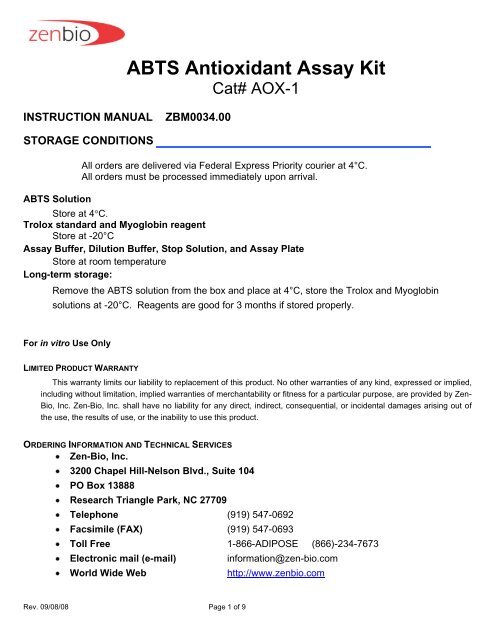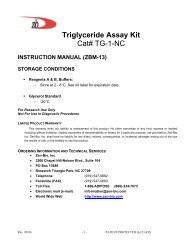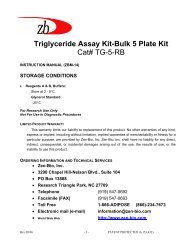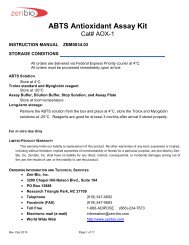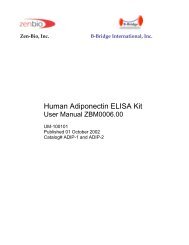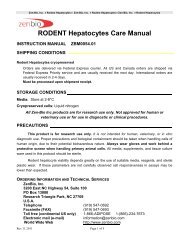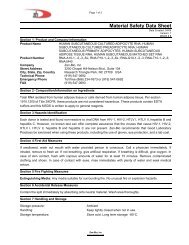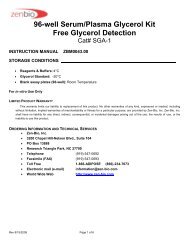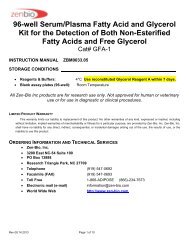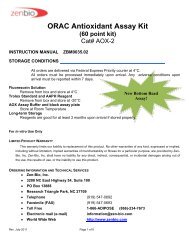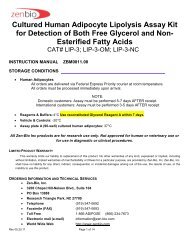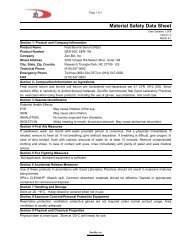ABTS Antioxidant Assay Kit - Zen-Bio Inc.
ABTS Antioxidant Assay Kit - Zen-Bio Inc.
ABTS Antioxidant Assay Kit - Zen-Bio Inc.
You also want an ePaper? Increase the reach of your titles
YUMPU automatically turns print PDFs into web optimized ePapers that Google loves.
<strong>ABTS</strong> <strong>Antioxidant</strong> <strong>Assay</strong> <strong>Kit</strong>Cat# AOX-1INSTRUCTION MANUALZBM0034.00STORAGE CONDITIONS<strong>ABTS</strong> SolutionAll orders are delivered via Federal Express Priority courier at 4°C.All orders must be processed immediately upon arrival.Store at 4 C.Trolox standard and Myoglobin reagentStore at -20°C<strong>Assay</strong> Buffer, Dilution Buffer, Stop Solution, and <strong>Assay</strong> PlateStore at room temperatureLong-term storage:Remove the <strong>ABTS</strong> solution from the box and place at 4°C, store the Trolox and Myoglobinsolutions at -20°C. Reagents are good for 3 months if stored properly.For in vitro Use OnlyLIMITED PRODUCT WARRANTYThis warranty limits our liability to replacement of this product. No other warranties of any kind, expressed or implied,including without limitation, implied warranties of merchantability or fitness for a particular purpose, are provided by <strong>Zen</strong>-<strong>Bio</strong>, <strong>Inc</strong>. <strong>Zen</strong>-<strong>Bio</strong>, <strong>Inc</strong>. shall have no liability for any direct, indirect, consequential, or incidental damages arising out ofthe use, the results of use, or the inability to use this product.ORDERING INFORMATION AND TECHNICAL SERVICES<strong>Zen</strong>-<strong>Bio</strong>, <strong>Inc</strong>.3200 Chapel Hill-Nelson Blvd., Suite 104PO Box 13888Research Triangle Park, NC 27709Telephone (919) 547-0692Facsimile (FAX) (919) 547-0693Toll Free 1-866-ADIPOSE (866)-234-7673Electronic mail (e-mail)World Wide Webinformation@zen-bio.comhttp://www.zenbio.comRev. 09/08/08 Page 1 of 9
Absorbance 405 nmINTRODUCTIONFree radicals and reactive oxygen species (ROS) are highly reactive molecules that aregenerated by normal cellular processes, environmental stresses, and UV irradiation. ROS reactwith cellular components, damaging DNA, carbohydrates, proteins, and lipids causing cellular andtissue injury. Excess production of reactive oxygen species can also lead to inflammation,premature aging disorders, and several disease states, including cancer, diabetes, andatherosclerosis. Organisms have developed complex antioxidant systems to protect themselvesfrom oxidative stress, however, excess ROS can overwhelm the systems and cause severedamage.The <strong>Zen</strong>-<strong>Bio</strong> <strong>ABTS</strong> <strong>Antioxidant</strong> <strong>Assay</strong> <strong>Kit</strong> can be used to determine the total antioxidantcapacity of biological fluids, cells, and tissue. It can also be used to assay the antioxidant activity ofnaturally occurring or synthetic compounds for use as dietary supplements, topical protection, andtherapeutics. The assay measures <strong>ABTS</strong> .+ radical cation formation induced by metmyoglobin andhydrogen peroxide. Trolox [6-Hydroxy-2,5,7,8-tetramethylchroman-2-carboxylic acid], a watersoluble vitamin E analog, serves as a positive control inhibiting the formation of the radical cation ina dose dependent manner. The antioxidant activity in biological fluids, cells, tissues, and naturalextracts can be normalized to equivalent Trolox units to quantify the composite antioxidant activitypresent. This assay measures radical scavenging by electron donation and when combined with<strong>Zen</strong>-<strong>Bio</strong>’s ORAC antioxidant assay kit, provides a comprehensive analysis of a test sample’santioxidant activity.0.7<strong>ABTS</strong> <strong>Assay</strong>0.60.5TroloxL-AscEGCGGallic0.40.30.20.100 50 100 150 200 250 300 350Concentration ( M)Effects of antioxidants in <strong>ABTS</strong> assayTrolox, Sodium L-ascorbate (L-Asc), Epigallocatechin gallate (EGCG),and Gallic acid (Gallic) were tested for their antioxidant activity in the<strong>ABTS</strong> antioxidant assay.Rev. 09/08/08 Page 2 of 9
ASSAY PROCEDURE.1. Remove the <strong>ABTS</strong> solution from the refrigerator and allow it to come to room temperature.2. Prepare Trolox standards as follows:Briefly spin down the contents of the 1.5 mM Trolox standard tube after thawing. Pipette 80l of <strong>Assay</strong> Buffer into the 1.5 mM Trolox standard tube provided and mix well byvortexing. This produces a diluted stock Trolox standard of 300 M. Pipette 50 l ofassay buffer into 6 tubes (not provided). Using the newly diluted stock Trolox solution,prepare a dilution series as depicted below. Mix each new dilution thoroughly beforeproceeding to the next. The 300 M stock dilution serves as the highest standard, and theassay buffer serves as the zero standard.80 l 50 l 50 l 50 l 50 l 50 l 50 l<strong>Assay</strong>BufferStd300M150M75M37.5M18.75M9.375M4.688M3. Prepare the Myoglobin Working Solution. Briefly spin down the contents of the Myoglobin stocksolution tube. Add 25 l Myoglobin stock solution to the Dilution Buffer bottle (contains 2.475 ml)and gently invert. Place the working solution on ice until needed.4. Add 10 l of samples or Trolox standards to individual wells of the assay plate provided, add 10l of assay buffer to individual wells as a negative control.5. Add 20 l of the myoglobin working solution to each of the wells containing standards andsamples from step 4.6. To begin the assay, add 100 l of the <strong>ABTS</strong> solution per well and place on plate shaker at roomtemperature. Allow the reaction to proceed for 5 minutes. To stop the reaction, add 50 l of StopSolution per well.7. Read absorbance using plate reader at a wavelength of 405 nm.Rev. 09/08/08 Page 4 of 9
Absorbance 405 nmTROLOX STANDARD CURVE.Generate standard curve: see example below[DO NOT use this standard curve to generate your data. This is an example.]M Trolox OD stdev0 0.871 0.0194.6875 0.864 0.0069.375 0.855 0.00318.75 0.829 0.01837.5 0.806 0.00675 0.742 0.013150 0.636 0.009300 0.436 0.013slope = -0.0015intercept= 0.8629R 2 = 0.996910.90.80.70.60.50.40.30.20.10Standard Curvey = -0.0015x + 0.8629R² = 0.99690 50 100 150 200 250 300M Troloxy = observed O.D.x = concentration of Trolox in MTo calculate x for each y, (i.e. to change the observed O.D. into Trolox equivalent concentration) use thefollowing equation:y=(slope) times (x) plus intercepty=mx+b so x=(y-b)/mx=(y – 0.8629)/(-.0015) where (-.0015)= slope of the line and 0.8629= y intercept. Be careful to enter theproper sign for the y intercept value as it may be a negative number.The R 2 value should be equal or greater then 0.98 for the standard curve to be valid. Any R 2values below 0.98, must have the standard curve run again.Data are expressed as M Trolox equivalent.Rev. 09/08/08 Page 5 of 9
Absorbance 405 nmAUCOPTIONAL KINETIC ASSAY PROCEDURE1. Prepare Trolox and myoglobin reagents as described above.2. Set-up plate reader for kinetic reading mode:Total time = 10 minutesInterval = 30 secondsAbsorbance= 405nm3. Add 10 l of samples or Trolox standards to individual wells of the assay plate provided, add 10 l ofassay buffer to individual wells as a negative control.4. Add 20 l of the myoglobin working solution to each of the wells containing standards and samples fromstep 3.5. To begin the assay, add 100 l of the <strong>ABTS</strong> solution per well and place in plate reader and begin readingabsorbance using the kinetic mode.TROLOX KINETIC STANDARD CURVETime(min.)Trolox concentration ( M)1500 750 375 187.5 93.75 46.875 23.4375 00 0.059 0.058667 0.060333 0.062 0.059667 0.080333 0.109333 0.1420.5 0.055667 0.056 0.058 0.059333 0.102667 0.159333 0.189667 0.2193331 0.055667 0.056333 0.057333 0.076333 0.183333 0.238667 0.268667 0.31.5 0.055667 0.055667 0.057667 0.154667 0.262 0.318333 0.35 0.3813332 0.055333 0.055667 0.058 0.233667 0.341667 0.398 0.431333 0.4632.5 0.056 0.056333 0.098333 0.314333 0.422667 0.478333 0.512667 0.5453 0.056333 0.056667 0.175667 0.394667 0.503 0.558 0.592667 0.6253333.5 0.056 0.056333 0.252 0.474 0.582 0.636667 0.672 0.7044 0.056667 0.056667 0.328667 0.554333 0.662 0.715333 0.751333 0.7834.5 0.057 0.057 0.405667 0.634667 0.742 0.794 0.830667 0.8623335 0.056333 0.056667 0.483 0.715333 0.820667 0.871333 0.909333 0.9413335.5 0.056667 0.077667 0.563333 0.797667 0.900667 0.95 0.99 1.0246 0.057333 0.154333 0.645 0.881333 0.981 1.032333 1.072 1.1096.5 0.057333 0.233667 0.729 0.966667 1.063 1.116333 1.155667 1.1967 0.057 0.313333 0.813 1.053 1.145333 1.201667 1.240667 1.2837.5 0.057333 0.396667 0.899333 1.142333 1.230667 1.29 1.328 1.3723338 0.058 0.481667 0.987667 1.233333 1.319333 1.380333 1.417667 1.4626678.5 0.058333 0.567667 1.075667 1.325667 1.408667 1.470333 1.507333 1.5539 0.058333 0.654667 1.164667 1.419 1.500333 1.562667 1.599 1.6449.5 0.059 0.743 1.254667 1.512667 1.594333 1.656333 1.692 1.73633310 0.059333 0.832333 1.346667 1.608 1.690667 1.751333 1.785667 1.82933321.81.61.41.210.80.60.40.200 2 4 6 8 10 12Time (minutes)Absorbance over time for Trolox standards375187.593.7546.87523.43750Area under the curve (AUC)AUC= 0.5+ f0+f1+...+f20+(0.5*f21)Where fx = Abs value at time points 0 – 10 min2520151050AUC1500 1.668667750 5.160833375 11.34033187.5 15.30993.75 17.1703346.875 18.28423.4375 19.012830 19.761670 100 200 300 400Concentration ( M)AUC values for increasing Trolox concentrationsAUCRev. 09/08/08 Page 6 of 9
Comparison of Stopped and Kinetic <strong>Assay</strong>sTrolox, Sodium L-ascorbate (L-Asc), Epigallocatechin gallate (EGCG), and Gallic acid (Gallic) were tested for theirantioxidant activity.<strong>ABTS</strong> Absorbance Values at 5 MinutesAUC Values for Kinetic <strong>Assay</strong>0.7250.60.5200.40.3TroloxL-AscEGCG1510TroloxL-AscEGCG0.20.1Gallic5Gallic00 100 200 300 40000 100 200 300 400Rev. 09/08/08 Page 7 of 9
ABCDEFGH1 2 3 4 5 6 7 8 9 10 11 12APPENDIX A: Plate layout.Rev. 09/08/08 Page 8 of 9
APPENDIX B: Protocol Flowchart<strong>ABTS</strong> ASSAYMake necessary test compounddilutions in <strong>Assay</strong> Buffer.Prior to assay, allow <strong>ABTS</strong> solution toequilibrate to room temperature, preparemyoglobin dilution and standards.Keep Trolox and myoglobin solutions onice until used.Add 10 l/well samples or standards toblank assay plate.PlateOOOOOOOOOOOOOOOOOOOOOOOOOOOOOOOOOOOOOOOOOOOOOOOOOOOOOOOOOOOOAdd 10 l samplesor standardsAdd 20 l/well myoglobin dilution to the plate(including the Trolox standards).PlateOOOOOOOOOOOOOOOOOOOOOOOOOOOOOOOOOOOOOOOOOOOOOOOOOOOOOOOOOOOOAdd 20 lmyoglobin solutionStart assay by adding 100 l/well <strong>ABTS</strong> solution.<strong>Inc</strong>ubate at 25 o C (room temperature) for 5minutes and stop reaction by adding 50l/well stop solution.Optionally, perform kinetic assay byplacing in plate reader and measureabsorbance at 405 nm every 30 secondsfor 10 minutes.PlateOOOOOOOOOOOOOOOOOOOOOOOOOOOOOOOOOOOOOOOOOOOOOOOOOOOOOOOOOOOOPlateOOOOOOOOOOOOOOOOOOOOOOOOOOOOOOOOOOOOOOOOOOOOOOOOOOOOOOOOOOOOAdd 100 l <strong>ABTS</strong>solutionAdd 50 l STOPsolutionStopped <strong>Assay</strong>: Measure the opticaldensity of each well at 405 nm usinga spectrophotometer plate reader.Rev. 09/08/08 Page 9 of 9


